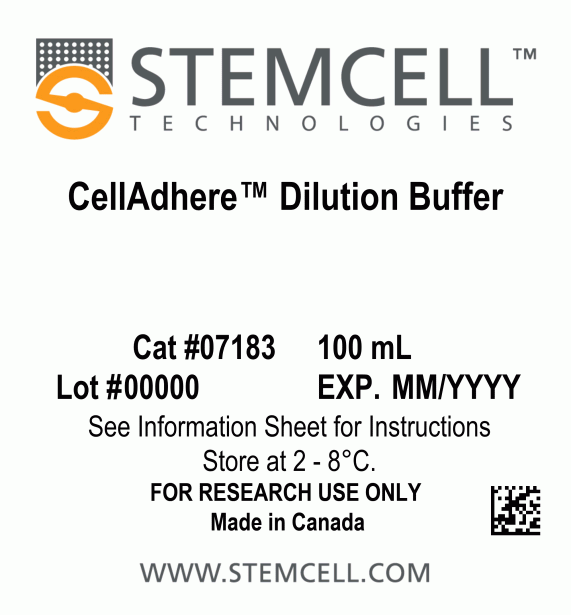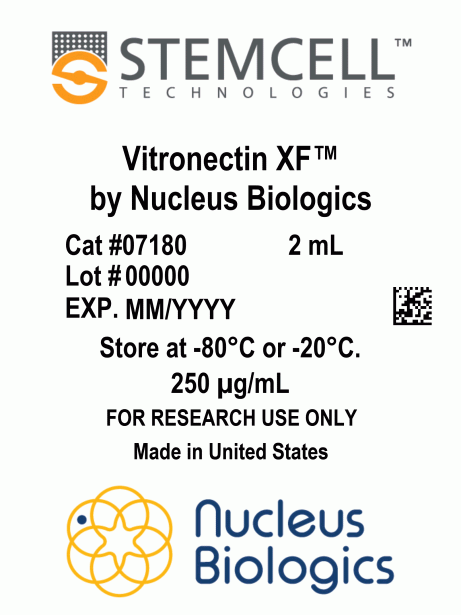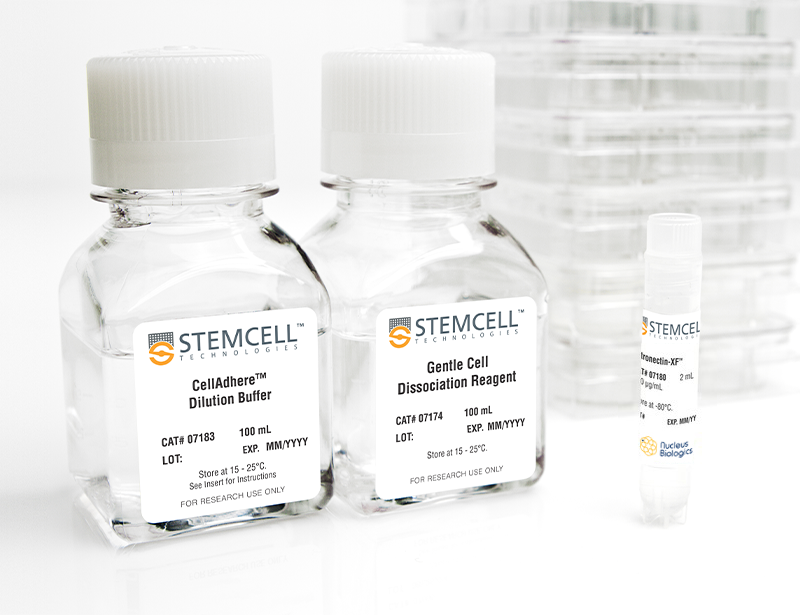Vitronectin XF™
Defined, xeno-free matrix that supports the growth and differentiation of human pluripotent stem cells under serum-free, feeder-free conditions
概要
Vitronectin XF™, developed and manufactured by Nucleus Biologics, is an effective alternative to Corning® Matrigel®. Vitronectin XF™ is a defined, xeno-free cell culture matrix that supports the growth and differentiation of human pluripotent stem cells. When used with mTeSR™1, mTeSR™ Plus, TeSR™-E8™, or TeSR™2, Vitronectin XF™ provides a defined culture system for the maintenance of human embryonic stem (ES) cells and human induced pluripotent stem (iPS) cells under feeder-free conditions. This system allows complete control over the culture environment, resulting in more consistent cell populations and reproducible results in downstream applications.
Note: Catalog #07180 is the matrix only and requires additional reagents (Catalog #07183, 07174 or 05872, and 27147) available for purchase separately or in a kit with Vitronectin XF™ (Catalog #07190 or 07191).
Note: Catalog #07180 is the matrix only and requires additional reagents (Catalog #07183, 07174 or 05872, and 27147) available for purchase separately or in a kit with Vitronectin XF™ (Catalog #07190 or 07191).
Advantages
• Defined, recombinant human protein
• Consistent, reproducible human ES and iPS cell cultures
• Convenient, room temperature plate coating
• Enzyme-free passaging
• Defined system when used with TeSR™-E8™, mTeSR™1, or TeSR™2
• Consistent, reproducible human ES and iPS cell cultures
• Convenient, room temperature plate coating
• Enzyme-free passaging
• Defined system when used with TeSR™-E8™, mTeSR™1, or TeSR™2
Cell Type
Endoderm, PSC-Derived, Pluripotent Stem Cells
Species
Human
技术资料
| Document Type | 产品名称 | Catalog # | Lot # | 语言 |
|---|---|---|---|---|
| Product Information Sheet | Vitronectin XF™ | 07180 | All | English |
| Product Information Sheet | CellAdhere™ Dilution Buffer | 07183 | All | English |
| Product Information Sheet | Vitronectin XF™ Kit with GCDR | 07190 | All | English |
| Product Information Sheet | Vitronectin XF™ Kit with ReLeSR™ | 07191 | All | English |
| Product Information Sheet | Non Tissue Culture-Treated 6-Well Plates | 27147 | All | English |
| Safety Data Sheet | Vitronectin XF™ | 07180 | All | English |
| Safety Data Sheet | CellAdhere™ Dilution Buffer | 07183 | All | English |
| Safety Data Sheet 1 | Vitronectin XF™ Kit with GCDR | 07190 | All | English |
| Safety Data Sheet 2 | Vitronectin XF™ Kit with GCDR | 07190 | All | English |
| Safety Data Sheet 3 | Vitronectin XF™ Kit with GCDR | 07190 | All | English |
数据及文献
Publications (4)
Cell cycle (Georgetown, Tex.) 2016 JAN
Non-integrating episomal plasmid-based reprogramming of human amniotic fluid stem cells into induced pluripotent stem cells in chemically defined conditions.
Abstract
Abstract
Amniotic fluid stem cells (AFSC) represent an attractive potential cell source for fetal and pediatric cell-based therapies. However, upgrading them to pluripotency confers refractoriness toward senescence, higher proliferation rate and unlimited differentiation potential. AFSC were observed to rapidly and efficiently reacquire pluripotency which together with their easy recovery makes them an attractive cell source for reprogramming. The reprogramming process as well as the resulting iPSC epigenome could potentially benefit from the unspecialized nature of AFSC. iPSC derived from AFSC also have potential in disease modeling, such as Down syndrome or $\$-thalassemia. Previous experiments involving AFSC reprogramming have largely relied on integrative vector transgene delivery and undefined serum-containing, feeder-dependent culture. Here, we describe non-integrative oriP/EBNA-1 episomal plasmid-based reprogramming of AFSC into iPSC and culture in fully chemically defined xeno-free conditions represented by vitronectin coating and E8 medium, a system that we found uniquely suited for this purpose. The derived AF-iPSC lines uniformly expressed a set of pluripotency markers Oct3/4, Nanog, Sox2, SSEA-1, SSEA-4, TRA-1-60, TRA-1-81 in a pattern typical for human primed PSC. Additionally, the cells formed teratomas, and were deemed pluripotent by PluriTest, a global expression microarray-based in-silico pluripotency assay. However, we found that the PluriTest scores were borderline, indicating a unique pluripotent signature in the defined condition. In the light of potential future clinical translation of iPSC technology, non-integrating reprogramming and chemically defined culture are more acceptable.
Stem Cell Reviews and Reports 2016 AUG
Functionalizing Ascl1 with Novel Intracellular Protein Delivery Technology for Promoting Neuronal Differentiation of Human Induced Pluripotent Stem Cells
Abstract
Abstract
Pluripotent stem cells can become any cell type found in the body. Accordingly, one of the major challenges when working with pluripotent stem cells is producing a highly homogenous population of differentiated cells, which can then be used for downstream applications such as cell therapies or drug screening. The transcription factor Ascl1 plays a key role in neural development and previous work has shown that Ascl1 overexpression using viral vectors can reprogram fibroblasts directly into neurons. Here we report on how a recombinant version of the Ascl1 protein functionalized with intracellular protein delivery technology (Ascl1-IPTD) can be used to rapidly differentiate human induced pluripotent stem cells (hiPSCs) into neurons. We first evaluated a range of Ascl1-IPTD concentrations to determine the most effective amount for generating neurons from hiPSCs cultured in serum free media. Next, we looked at the frequency of Ascl1-IPTD supplementation in the media on differentiation and found that one time supplementation is sufficient enough to trigger the neural differentiation process. Ascl1-IPTD was efficiently taken up by the hiPSCs and enabled rapid differentiation into TUJ1-positive and NeuN-positive populations with neuronal morphology after 8 days. After 12 days of culture, hiPSC-derived neurons produced by Ascl1-IPTD treatment exhibited greater neurite length and higher numbers of branch points compared to neurons derived using a standard neural progenitor differentiation protocol. This work validates Ascl1-IPTD as a powerful tool for engineering neural tissue from pluripotent stem cells.
Nature methods 2011 MAY
Chemically defined conditions for human iPSC derivation and culture.
Abstract
Abstract
We re-examine the individual components for human embryonic stem cell (ESC) and induced pluripotent stem cell (iPSC) culture and formulate a cell culture system in which all protein reagents for liquid media, attachment surfaces and splitting are chemically defined. A major improvement is the lack of a serum albumin component, as variations in either animal- or human-sourced albumin batches have previously plagued human ESC and iPSC culture with inconsistencies. Using this new medium (E8) and vitronectin-coated surfaces, we demonstrate improved derivation efficiencies of vector-free human iPSCs with an episomal approach. This simplified E8 medium should facilitate both the research use and clinical applications of human ESCs and iPSCs and their derivatives, and should be applicable to other reprogramming methods.
Stem cells and development 2010 AUG
Roles of integrins in human induced pluripotent stem cell growth on Matrigel and vitronectin.
Abstract
Abstract
Human induced pluripotent stem cells (iPSCs) hold promise as a source of adult-derived, patient-specific pluripotent cells for use in cell-based regenerative therapies. However, current methods of cell culture are tedious and expensive, and the mechanisms underlying cell proliferation are not understood. In this study, we investigated expression and function of iPSC integrin extracellular matrix receptors to better understand the molecular mechanisms of cell adhesion, survival, and proliferation. We show that iPSC lines generated using Oct-3/4, Sox-2, Nanog, and Lin-28 express a repertoire of integrins similar to that of hESCs, with prominent expression of subunits alpha5, alpha6, alphav, beta1, and beta5. Integrin function was investigated in iPSCs cultured without feeder layers on Matrigel or vitronectin, in comparison to human embryonic stem cells. beta1 integrins were required for adhesion and proliferation on Matrigel, as shown by immunological blockade experiments. On vitronectin, the integrin alphavbeta5 was required for initial attachment, but inhibition of both alphavbeta5 and beta1 was required to significantly decrease iPSC proliferation. Furthermore, iPSCs cultured on vitronectin for 9 passages retained normal karyotype, pluripotency marker expression, and capacity to differentiate in vitro. These studies suggest that vitronectin, or derivatives thereof, might substitute for Matrigel in a more defined system for iPSC culture.




